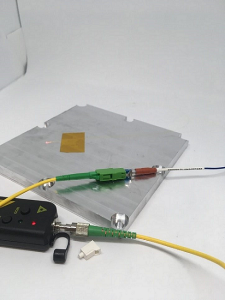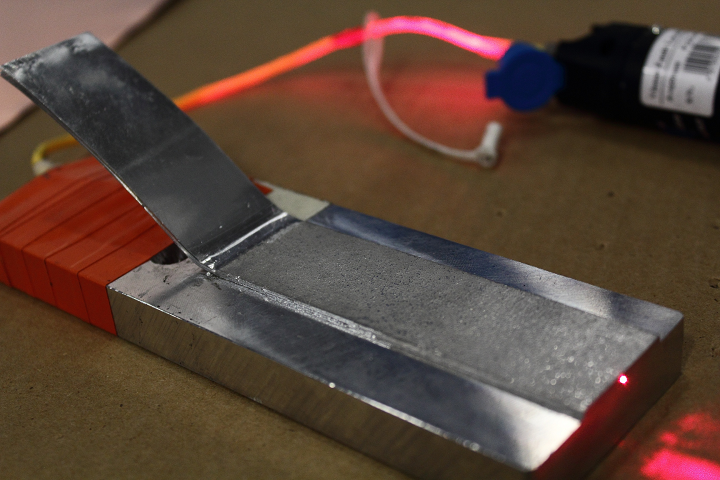Fabrisonic and Luna Innovations Making 3D Printed Smart Structures with Embedded Fiber Optic Sensors
Ohio company Fabrisonic is well-known in the industry for its hybrid metal 3D printing process, called Ultrasonic Additive Manufacturing (UAM), which uses high frequency ultrasonic vibrations to merge layers of metal foil together in a solid-state. Now, it’s collaborating with optical measurement technology leader Luna Innovations to make 3D printed smart structures.
The collaborative team will use these structures to answer questions such as finding a critical component’s exact strain during operation, and determining if improvements are possible by monitoring an additive manufacturing process in situ.
“Fabrisonic has commercialized a new metal 3D printing process, which occurs at very low temperatures, allowing the team to easily embed Luna fiber optic sensors into solid metal parts,” Fabrisonic’s president and CEO Mark Norfolk wrote. “With complementary technologies, Luna and Fabrisonic’s “smart structures” can be used to collect data for health monitoring and high fidelity command/control as well as for basic science and research.”
The SBIR/STTR program recently awarded the joint Fabrisonic and Luna Innovations team two separate research contracts, which will both focus on embedding sensors into key 3D printed parts in order to deliver important data from inside the components.

Metal build plate with embedded fiber optic sensors, which will be installed in a PBF 3D printer to study the process and quantify quality metrics.
The first research contract will focus on Fabrisonic and Luna developing a smart pipe for fuel systems at NASA. The program will use the pipe for fuel systems which will integrate Luna’s strain sensors into a 3D printed pipe wall to measure such things as heat flux, temperature, and pressure. The strain sensing fibers will be embedded into pipes made of stainless steel and aluminum, which will allow for the “continuous monitoring of strain in the pipe wall.”
Once the fibers have been embedded, Fabrisonic and Luna will seal and cyclically pressure the pipe in order to collect data. After successful calibration, the 3D printed pipe with integral sensing will make it possible for the team to achieve real-time telemetry of temperatures and pressure at multiple important points in NASA’s fuel systems.
The second contract involves the team using Fabrisonic’s UAM process to create a smart baseplate for laser powder bed fusion 3D printers with the Defense Logistics Agency (DLA). Fabrisonic will embed proprietary fibers from Luna into solid metal instrumented plates, which will be placed into a 3D printer to serve as a powder build’s beginning point.
Then, the team will use the Luna ODiSl measurement system, which measures the residual strain on complex surfaces of 3D printed components, in order to collect hundreds of temperature and strain data points during the build in real time. The ultimate project goal is to improve the overall methodology for powder bed fusion 3D printing processes, in addition to determining how to properly measure capability and anticipate any possible issues before they occur.
 Additionally, the team at Fabrisonic and Luna is working with multiple other partners in order to embed fiber optic sensors in highly demanding environments, such as nuclear reactors.
Additionally, the team at Fabrisonic and Luna is working with multiple other partners in order to embed fiber optic sensors in highly demanding environments, such as nuclear reactors.
To learn more about how Fabrisonic’s patented solid state UAM metal 3D printing process can be used to integrate fiber optic strain sensors and other temperature-sensitive components directly into dense metal, you can download and read a new technical paper, titled “Building Fiber Optic Strain Sensor into Metal Components,” that was written Dr. Adam Hehr, a Research Engineer at Fabrisonic.
Discuss this story and other 3D printing topics at 3DPrintBoard.com or share your thoughts in the Facebook comments below.
[Source/Images: Fabrisonic]Subscribe to Our Email Newsletter
Stay up-to-date on all the latest news from the 3D printing industry and receive information and offers from third party vendors.
You May Also Like
Gorilla Sports GE’s First 3D Printed Titanium Cast
How do you help a gorilla with a broken arm? Sounds like the start of a bad joke a zookeeper might tell, but it’s an actual dilemma recently faced by...
Nylon 3D Printed Parts Made More Functional with Coatings & Colors
Parts 3D printed from polyamide (PA, Nylon) 12 using powder bed fusion (PBF) are a mainstay in the additive manufacturing (AM) industry. While post-finishing processes have improved the porosity of...
$25M to Back Sintavia’s Largest Expansion of Metal 3D Printing Capacity Since 2019
Sintavia, the digital manufacturing company specializing in mission-critical parts for strategic sectors, announced a $25 million investment to increase its production capacity, the largest expansion to its operations since 2019....
Velo3D Initiates Public Offering in a Bid to Strengthen Financial Foundations and Drive Future Growth
Velo3D (NYSE: VLD) has been among a number of publicly traded 3D printing firms that have attempted to weather the current macroeconomic climate. After posting a challenging financial report for 2023,...
































